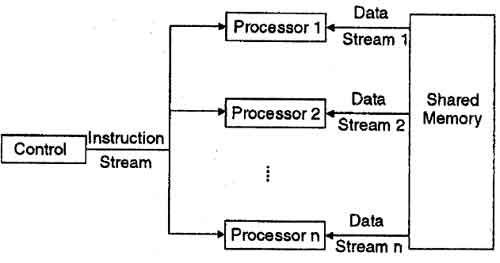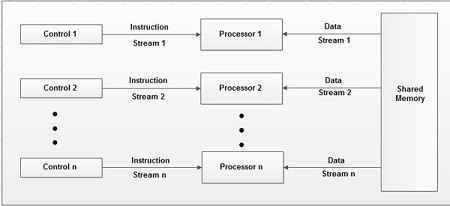Parallel Processing Systems are designed to speed up the execution of programs by dividing the program into multiple fragments and processing these fragments simultaneously. Such systems are multiprocessor systems also known as tightly coupled systems. Parallel systems deal with the simultaneous use of multiple computer resources that can include a single computer with multiple processors, a number of computers connected by a network to form a parallel processing cluster or a combination of both.
Parallel computing is an evolution of serial computing where the jobs are broken into discrete parts that can be executed concurrently. Each part is further broken down to a series of instructions. Instructions from each part execute simultaneously on different CPUs.
Parallel systems are more difficult to program than computers with a single processor because the architecture of parallel computers varies accordingly and the processes of multiple CPUs must be coordinated and synchronized. Several models for connecting processors and memory modules exist, and each topology requires a different programming model. The three models that are most commonly used in building parallel computers include synchronous processors each with its own memory, asynchronous processors each with its own memory and asynchronous processors with a common, shared memory. Flynn has classified the computer systems based on parallelism in the instructions and in the data streams. These are:
1. Single instruction stream, single data stream (SISD).
2. Single instruction stream, multiple data stream (SIMD).
3. Multiple instruction streams, single data stream (MISD).
4. Multiple instruction stream, multiple data stream (MIMD).
The above classification of parallel computing system is focused in terms of two independent factors: the number of data streams that can be simultaneously processed, and the number of instruction streams that can be simultaneously processed. Here ‘instruction stream’ we mean an algorithm that instructs the computer what to do whereas ‘data stream’ (i.e. input to an algorithm) we mean the data that are being operated upon.
Even though Flynn has classified the computer ‘systems into four types based on parallelism but only two of them are relevant to parallel computers. These are SIMD and MIMD computers.
SIMD computers are consisting of ‘n’ processing units receiving a single stream of instruction from a central control unit and each processing unit operates on a different piece of data. Most SIMD computers operate synchronously using a single global dock. The block diagram of SIMD computer is shown below:

MIMD computers are consisting of ‘n’ processing units; each with its own stream of instruction and each processing unit operate on unit operates on a different piece of data. MIMD is the most powerful computer system that covers the range of multiprocessor systems. The block diagram of MIMD computer is shown.

The SIMD systems are easier to program because it deals with single thread of execution. On the hand, the MIMD machines are more efficient because you can utilize the full machine power.
Parallel operating systems are primarily concerned with managing the resources of parallel machines. A parallel computer is a set of processors that are able to work cooperatively to solve a computational problem. So, a parallel computer may be a supercomputer with hundreds or thousands of processors or may be a network of workstations.
A few years ago, parallel computers could be found only in research laboratories and they were used mainly for computation intensive applications like numerical simulations of complex systems. Today, there are a lot of parallel computers available in the market; used to execute both data intensive applications in commerce and computation intensive applications in science and engineering.
Today, new applications arise and demand faster computers. Commercial applications are the most used on parallel computers. A computer that runs such an application; should be able to process large amount of data in sophisticated ways. These applications include graphics, virtual reality, and decision support, parallel databases, medicine diagnosis and so on. We can say with no doubt that commercial applications will define future parallel computers architecture but scientific applications will remain important users of parallel computing technology.
Concurrency becomes a fundamental requirement for algorithms and programs. A program has to be able to use a variable number of processors and also has to be able to run on multiple processors computer architecture. According to Tanenbaum, a distributed system is a set of independent computers that appear to the user like a single one. So, the computers have to be independent and the software has to hide individual computers to the users. MIMD computers and workstations connected through LAN and WAN are examples of distributed systems. The main difference between parallel systems and distributed systems is the way in which these systems are used. A parallel system uses a set of processing units to solve a single problem A distributed system is used by many users together.
 Dinesh Thakur holds an B.C.A, MCDBA, MCSD certifications. Dinesh authors the hugely popular
Dinesh Thakur holds an B.C.A, MCDBA, MCSD certifications. Dinesh authors the hugely popular